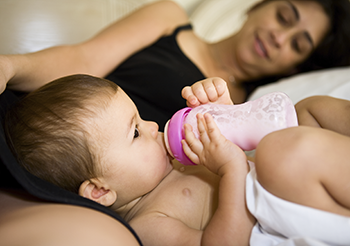The Effect of Birthing Method on the Infant Gut Microbiota
Abstract
Birthing methods, both vaginal and cesarean section play an essential role in the development of the infant. There has been recent interest and research surrounding the microbiome of the infant and how the bacteria they possess have a direct link to their delivery. The bacteria the infant ingests from the mother’s birth canal helps to build the immune system and better digest breast milk and solid foods. The changes of the vaginal microbiome during pregnancy give clues as to how similar the microbiome of that infant is and how important it be that the infant receives these bacteria.
The incidence of C-section relates to both the necessity of the procedure in times of emergencies, as well as elective surgery to potentially avoid the possible complications of birth. In the baby who is born via C-section, the microbiome that is developed is much less diverse than the baby born vaginally. These babies are at a higher risk of needing antibiotics, which can decrease bacterial diversity immensely. There is an increased risk for the development of asthma, allergies, obesity and other illnesses and diseases in those babies who are born C-section.
The Human Flora
The human body is made up of trillions of microorganisms (Knight, 2015). that affect both the functional and physiological aspects of the human, as well as their susceptibility to pathogens (Davis, 1996). Development of the human flora begins at childbirth and continues to develop well into adulthood. Bacteria thrive in certain environments, which results in large colonies among different parts of the body. The skin harbors a relatively consistent bacterial flora, with most bacteria remaining on the skin, while some attach to the nasal mucosa or deep hair follicles. In any given human being, there are about 10 trillion human cells to 100 trillion microbial cells and 20,000 human genes versus 20 million microbial genes (Knight, 2015).This equates to an average of three pounds of microbes in a human being with those microbes clearly outnumbering human cells. Having a vast number of microbes is imperative to the health of the human race, as they play a key role in fighting pathogens (Davis, 1996).
The formation of the human microbiota begins during the birthing process, making the vaginal microbiome a key role in that development. The vaginal microbiome is one that remains very subjective, as the bacteria present depends greatly on the woman’s age and race. (Akst, 2014). The most commonly found vaginal bacteria is the. Lactobacilli act as the mediators in the vagina by interacting with the environment to sustain the traditional conditions necessary for the vagina (Nissl, 2014). These bacterium create lactic acid that helps to achieve the natural acidic pH. A disturbed pH prompts the Lactobacilli to produce more lactic acid to preserve the environmental conditions. Maintaining an acidic environment in the vagina helps to protect the woman from potentially pathogenic bacteria. While it has been thought that the Lactobacilli tend to be the most dominant bacteria in the vagina, race may determine how much is actually present. In a study among four hundred women, the majority were found to have a strain of Lactobacillus as the most dominant bacteria in the vagina (Akst, 2014). It was also discovered that Asian women and caucasian women were found to have a higher rate of the bacteria in their vaginal microbiome compared to Hispanic and black women (Akst, 2014). For those women whose vaginal bacteria was not dominated by Lactobacillus, other anaerobic bacteria were found that helped to maintain the acidic environment. (Akst, 2014).
A second microbe that is found in vagina is Streptococcus agalactiae, which is a routinely healthy bacterium. A weakened immune system that results in fewer antibodies to fight the harmful pathogenic characteristics of this bacterium can produce damaging effects on the environment. These bacteria are hemolytic, which classifies them as potentially dangerous to neonates, who are highly susceptible to new microorganisms, who are born from a mother that is colonized (Stevens, 2002) (Kaplan, 2002).
Another microbe that is commonly found in the vagina is the Gardnerella vaginalis bacteria. While it can sometimes cause harmful effects, such as if it is passed to the newborn through birth, it is also found that in some cases, no harm may be done with a finding that about a quarter of all healthy women harbor this bacteria with no harm (Group B Strep Infection, 2012). This bacteria works to elevate the pH of the vagina and change the environment. They are known for creating protective biofilms against antibiotics and activate an inflammatory response that can displace Lactobacilli by raising the pH in the vagina (Saunders et al., 2007)
The Birthing History
Vaginal Birth
Changes of Mother's Microbiota in Pregnancy
GBS in Pregnancy
Cesarean Section Birth
Innoculating Newborns with Mother's Vaginal Secretions
The NICU
Breastfeeding and Infant Formula
Antibiotics and the Newborn
How Does Delivery Method Affect the Child's Life
Conclusion
References
Edited by Meryl Jones, student of Rachel Larsen at the University of Southern Maine

